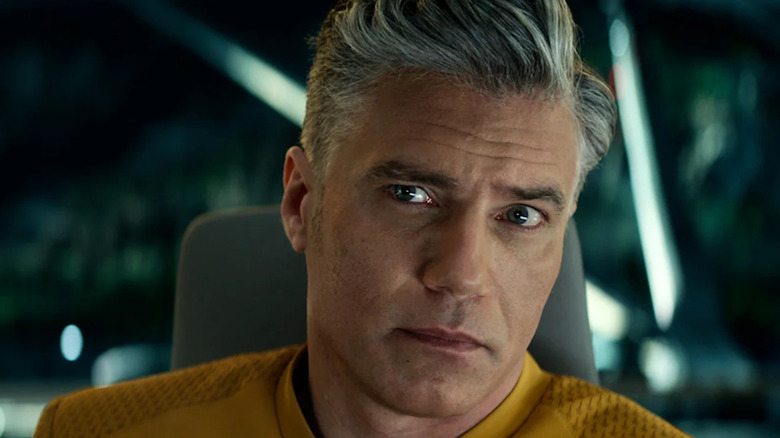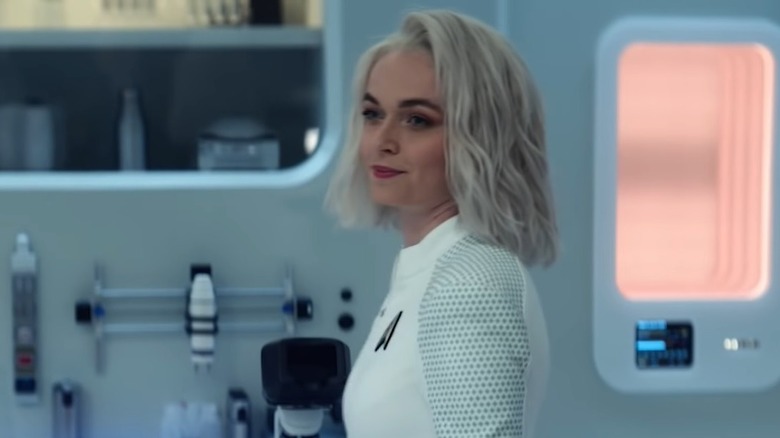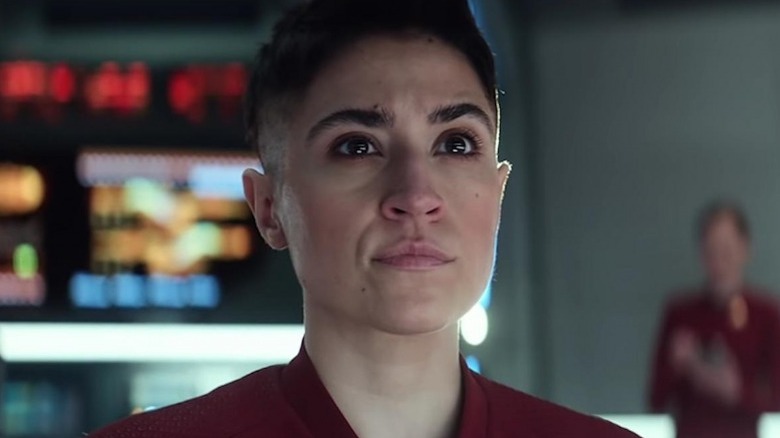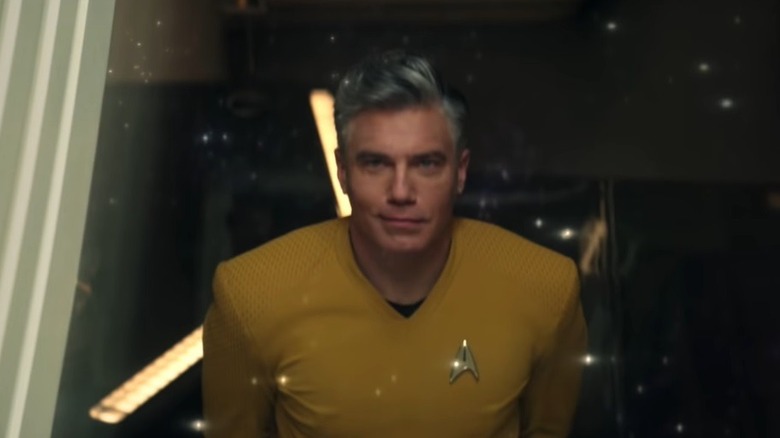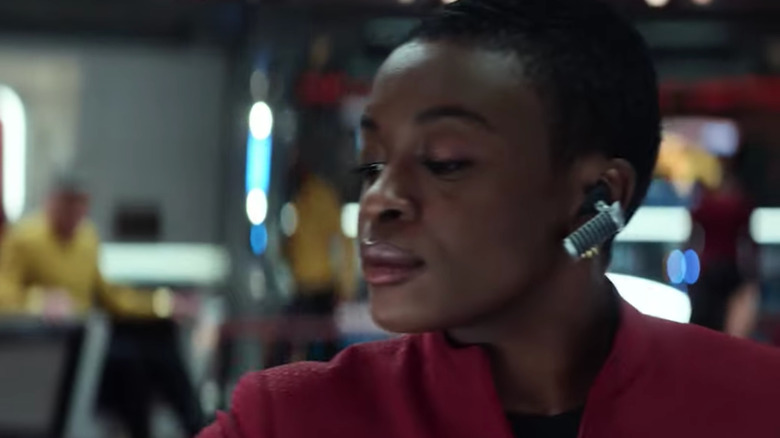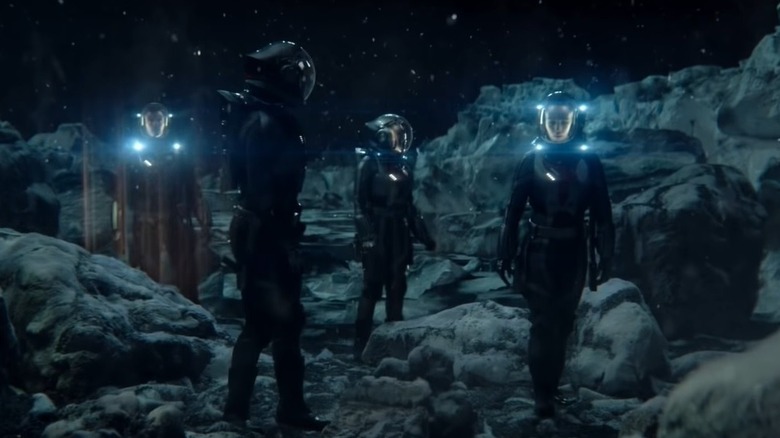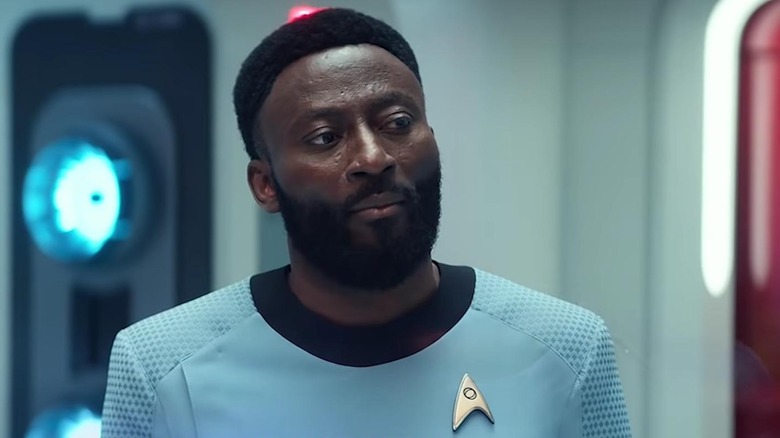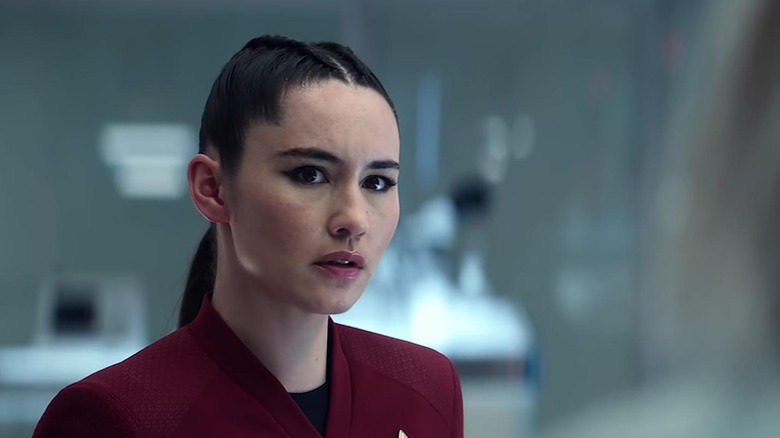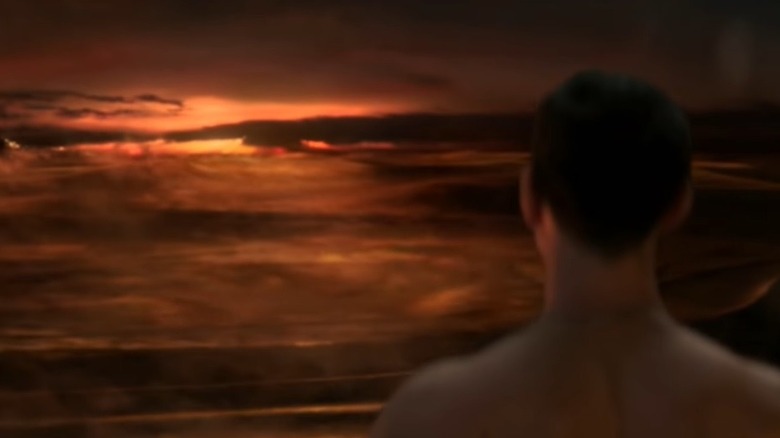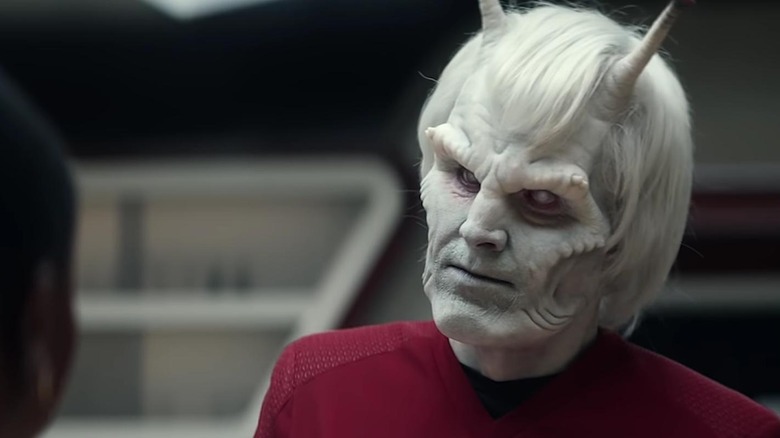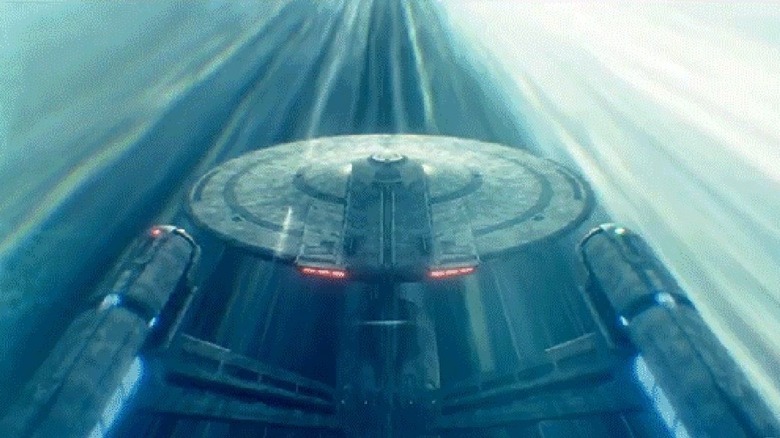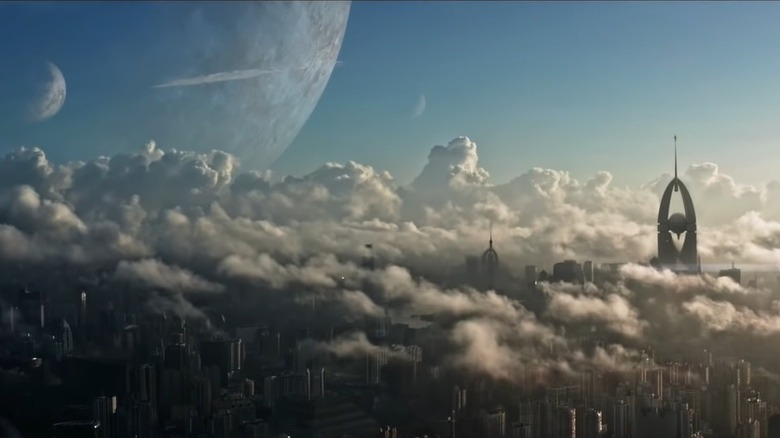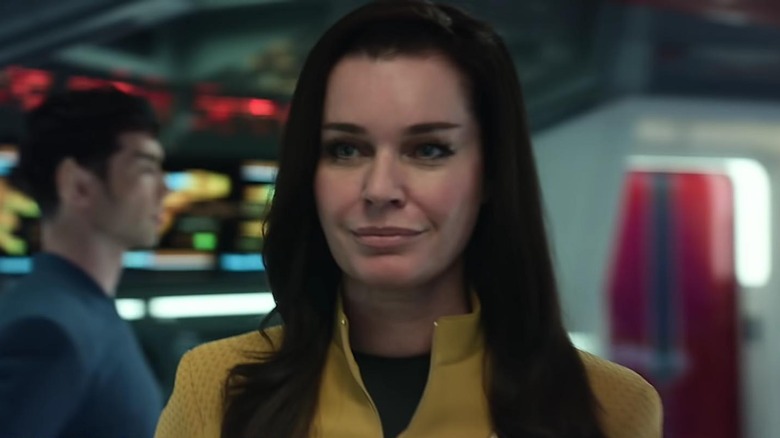Things We Want To See In Star Trek: Strange New Worlds
Following a divisive first year, "Star Trek: Discovery" ended its first season on a cliffhanger with the arrival of the USS Enterprise. When it returned for Season 2, audiences met not just Mr. Spock, now played by actor Ethan Peck, but Captain Christopher Pike, and his first officer, known only as Number One. It was a bold move to bring back not just the iconic Spock, but Pike and Number One too, who had appeared in the original unaired pilot of "Star Trek."
However, it wasn't just to appeal to nostalgia, as the concept that audiences petitioned for was finally announced: Pike, Spock, and Number One would be getting their own series, "Star Trek: Strange New Worlds," which would debut on Paramount+ in May of 2022. With additional crew members including Dr. M'Benga, Cadet Uhura, and Christine Chapel, this would be a return to classic "Star Trek," and the first teaser had fans buzzing about what could be in store.
While both "Discovery" and "Star Trek: Picard" have proven divisive, fans of the "Star Trek: The Original Series" are hopeful this new spin-off will be a return to traditional "Star Trek" ideals. From episodic stories to moral dilemmas and social commentary, here are the things we're hoping to see in "Star Trek: Strange New Worlds."
A classic sci-fi procedural
Since 1966, "Star Trek" has had seven live-action series. Today, we are seemingly in a new golden age for the franchise, with three series airing episodes in 2022. However, since the return of the franchise to television in 2017, live-action "Star Trek" has embraced modern long-form stories in a way that it rarely has before. Even when the highly acclaimed "Deep Space Nine" was running with ongoing arcs, it was still more or less made up of standalone stories within each 45-minute episode.
If "Star Trek: Strange New Worlds" is really going to recapture the spirit of classic "Star Trek," it will need to ditch the season-long single stories of "Discovery" and "Picard" and go back to being the science fiction procedural that older fans loved from the '60s and the '90s. A return to form would offer fans single-episode stories, a new adventure each week, and a concrete resolution at the end of every episode. From early interviews with individuals behind the scenes, it sounds like that's exactly what we're going to get.
"We are returning fundamentally to episodic storytelling," said producer Akiva Goldsman in an interview with TrekMovie.com. But that doesn't mean a hard reset with every new adventure. "Our characters will carry with them what they suffer from, or what they learned, from episode to episode. But the stories are episodic." If what Goldsman says is true, this is one hope we have for the series that may already be in the bag.
Personal stories and quieter moments
One element fans of "Star Trek" from the '60s or even the '90s might appreciate is the quieter moments often seen aboard the Enterprise. Not every "Star Trek" episode has to be a rousing adventure, with fast-paced action and high-stakes drama. What often made "Star Trek" great was what happened on the ship between those experiences, whether it was a personal conversation in a crew member's quarters about their personal struggle or a light-hearted moment in Ten Forward.
In a strong story, those smaller scenes allow the narrative space to breathe, making the bigger moments land with more weight. Oftentimes, they also serve to act as a counterpoint to the sci-fi elements of the episode, with a character's story mirroring — or contrasting — the more intense drama. Whether it's Captain Pike, Lt. Spock, or Cadet Uhura, the adventure can serve to help that week's central character grow and learn. These moments are also key to us getting to know the cast of the series as well-rounded, three-dimensional characters instead of cardboard cutouts.
Modern "Star Trek" has had some incredible stories and dramatic moments but can sometimes feel like they are rushing from big moment to big moment, while quiet interludes are little more than a roadblock to the action. In "Strange New Worlds" we'd like to see the action take a back seat, with the quieter, more personal stories driving the narrative.
Some light-hearted humor
One thing modern live-action "Star Trek" has been missing is the light-hearted tone of older series. While "Star Trek: Discovery" has its lighter moments, there's no denying it's a more serious and dramatic take on the material. While that definitely has its place in a broad universe of shows, we think it's time that the franchise embraced more wit and humor. Set aboard the original Enterprise, "Strange New Worlds" would be the perfect place to establish a lighter atmosphere.
The crew of Enterprise from "The Original Series" and "The Next Generation" often encountered fun characters who were often the source of laughs in even the most serious episodes. The original "Star Trek," in particular, sometimes felt like a sci-fi sitcom with Kirk or Spock regularly making wry observations just as the credits rolled. Even surly characters like Lt. Worf and Dr. McCoy occasionally got a few humorous one-liners.
"Star Trek: Strange New Worlds" would be wise to go back to the franchise's roots with more levity and humor to avoid the overwhelming melodrama of more recent live-action "Star Trek" series. The show can still pack in plenty of dramatic and intense sequences, but a lighter touch feels like just what "Star Trek" needs. In that way, "Strange New Worlds" could act as a balance for the franchise against the more gritty tone of "Discovery" and "Picard."
A family friendly series
"Star Trek: Discovery" and "Star Trek: Picard" aren't just more intense and melodramatic. They're designed for more mature audiences. Including adult language and even quasi-explicit sex scenes, many longtime Trekkies have lamented the loss of the franchise's traditionally family-friendly nature. While the animated "Star Trek: Prodigy" has been designed to appeal to kids, we still think there's more than enough room for an all-ages "Star Trek" series. "Strange New Worlds," set aboard the original starship Enterprise, and featuring many well-known and iconic characters, seems like the ideal platform to provide a "Star Trek" series that appeals to both kids and adults.
From "The Original Series" to "Voyager," multiple generations grew up watching "Star Trek" at home and on the big screen. However, when "Star Trek: Discovery" debuted in 2017, fans were surprised to see the new series was rated TV-14, with some episodes as harshly rated as TV-MA. The parental guidance noted the shows included violence, language, and sexual situations, making the series a tough watch for families. With "Star Trek: Picard" continuing the trend, we want to see "Strange New Worlds" to go back to the all-ages adventure and drama, so older fans can watch with their kids and raise a whole new generation of child Trekkies.
Handwaving all the differences
"Star Trek" has been retconning itself since the very beginning, or at the very least since their first live-action revival, the 1979 film "Star Trek: The Motion Picture." For that first big-screen adventure, the Enterprise was completely remade, and the infamous Klingon baddies were entirely redesigned with their new forehead ridges. The story made sure to explain that the Enterprise had undergone a radical "refit" that accounted for its new look, but no reason was ever given for the change in the Klingons, simply handwaving the differences. We're hoping that with all the visual changes we'll be seeing to both the Enterprise as well as characters like Uhura, Pike, and Spock, they stick with the handwaving.
Of course, in a 2005 episode of "Star Trek: Enterprise," the franchise would come up with an elaborate explanation for why the Klingons looked different in the movies. They crafted a multi-part saga that retconned the change as the result of genetic experimentation. While those episodes are well-loved and highly rated, it began an expectation among the fandom that changes to "Star Trek" needed to be explicitly explained. Whatever you think of the visual redesigns made for "Star Trek: Discovery," producers were wise not to dwell on the Klingon's latest new look, the seemingly canon-breaking use of holodecks, and other apparent inconsistencies collected by fans on Reddit.
While producers could and should give real-world justifications for their alterations off-screen to put fans at ease, we hope they won't spend too much energy on-screen explaining any retcons to "Star Trek" history.
Diplomacy and problem solving
"Star Trek" fans love a good space battle, but in the old days, when TV budgets were smaller and special effects much more limited, writers had to find other ways of crafting an exciting climax each week. Big action sequences proved few and far between, with Kirk, Spock, and Captain Picard opting for negotiations over firing phasers. However, even when they did go to red alert, the action was rarely explosive. Sometimes it was a simple shaking of the camera and a little smoke from off-screen. Other times it was an exterior shot of the ship and a single phaser beam.
What we might want most from "Strange New Worlds" is for a little less gung-ho starship action and a little more diplomacy. "Star Trek" has often had the reputation as a dialogue-heavy science fiction series, and after some high-octane thrills in other shows, that's exactly what we're hoping for on Pike's Enterprise. It would be a welcome change to see Pike talking his way out of trouble instead of shooting his way out.
After all, thoughtful problem solving was a hallmark of "Star Trek" for decades, and we'd love to see that make a comeback. The climax of an episode doesn't have to be a big action sequence, but instead the tension of working out of a sticky situation, which can be just as engaging as seeing starships shoot it out with phasers.
A true ensemble
Think back to the original "Star Trek," and you'll recall that the series mainly revolved around the trifecta of Captain Kirk, Mr. Spock, and Dr. McCoy. It wasn't until "Star Trek: The Next Generation" that the franchise became a true ensemble. There, and perhaps even moreso in "Deep Space Nine," audiences became just as well acquainted with the other members of the crew as they did with its captain. Many episodes of "The Next Generation" and "Deep Space Nine" revolved around the likes of Worf, Counselor Troi, and Chief O'Brien, with some episodes even focusing on recurring characters like Lt. Barclay or Garak.
While "Star Trek: Discovery" has done a better job of late in expanding the focus to encompass more of the crew, it's hard not to notice that the series is almost entirely built around the series' main character, Michael Burnham. We want "Strange New Worlds" to be more than a one-man Captain Pike show — and more than the trio of he, Spock, and Number One. We want the series to give real time to the other members of the crew and its many senior officers: Cadet Uhura, Dr. M'Benga, Ensign Ortega, La'an Noonien-Singh, and the Andorian Hemmer. Let's learn about who these characters are beyond what they do on the bridge, give them stories of their own, and make "Star Trek" a true ensemble again.
Smallers stakes, more impactful stories
Since the first J.J. Abrams film in 2009, "Star Trek" has become marked by big stories with bigger emotions. The dangers faced by Starfleet's finest have become broader and bolder than ever, with dastardly vengeance-seeking villains and terrifying interstellar dangers that threaten the entire Federation, and every decision the crew makes seemingly has galactic consequences. But "Star Trek" of old was rarely so big and awe-inspiring, often telling smaller stories that impacted just a single planet, a single ship, or sometimes just a single character.
We're hoping "Star Trek: Strange New Worlds" will scale back its stories, because bigger stakes don't always mean better drama. Not every story has to have the fate of the universe hanging in the balance, nor endanger billions of lives to feel important. In fact, the best stories are often the ones that affect the characters themselves more than the Federation. We've already seen plenty of movies and episodes where our heroes save the galaxy, and we'll likely see many more on the other shows and upcoming "Star Trek" movies.
For "Strange New Worlds" though, we want smaller stories, with problems that help our heroes learn, and personal tragedies that help them grow. Because those stories are often far more impactful and emotionally resonant to an audience than a villain threatening an entire galaxy.
Moral dilemmas and social commentary
J.J. Abrams, director of the first two rebooted "Star Trek" movies, once explained that classic "Star Trek" never really appealed to him. During an appearance on The Daily Show with Jon Stewart, he stated, "I would try, I would watch episodes, but it always felt too philosophical to me." Ultimately, Abrams would make his version of "Star Trek" a fast-paced action-adventure series that discarded the philosophy.
Since then, perhaps thanks to the box office success of those films, the new "Star Trek" television series seem to have adopted that same ethos. However, we feel it's time "Trek" went back to its philosophical roots and used science fiction the way it was intended: to muse on social issues, examine complex moral dilemmas, and consider the problems of today through the lens of tomorrow.
Whether it was aboard the Enterprise, Deep Space Nine, or Voyager, the best stories on "Star Trek" were often thought-provoking examinations of problems of the day that put characters into impossible ethical quandaries. Racism, LGBTQ rights, and class inequality are all issues that have been touched on by the franchise before, and if "Strange New Worlds" is indeed going to be classic "Star Trek," it will tread back into those waters. If the series can slow down the pace and focus on smaller stakes, as we're hoping to see, "Strange New Worlds" will be the ideal venue to discuss issues society is dealing with today.
The Enterprise as a character
Throughout "Star Trek" history, the ship at the center of each series — or space station in the case of "Deep Space Nine" — has often been a character unto itself. That's another element to the franchise that feels like it's been missing since its big-budget revival in 2009. These days, the titular starship Discovery, the freighter La Sirena on "Star Trek: Picard," and even the USS Protostar on "Prodigy" are little more than the vessel that ferries the crew to their adventures. Sure, the ships have their unique qualities — such as the Discovery's spore drive and the Protostar's proto-drive — but we'd love to see "Strange New Worlds" embrace the original Enterprise as a character all its own.
Let's explore more of the ship we've never seen by spending more time off the bridge and out of the corridors. Where does the crew unwind when off duty? What other unique facilities does it have, and how might they affect an episode's story? Considering that it is set aboard one of the most iconic starships in science fiction history, "Strange New Worlds" would be wise to show us as much of the ship as possible. Maybe the series could offer a few bottle episodes set entirely within its confines, or even a specific area of the ship we haven't explored yet. Let's see the Enterprise's best qualities, its many quirks, and the crew's connection to their home amongst the stars.
A pioneering spirit
We've heard from producers that "Strange New Worlds" will not be the same dark melodrama as other shows in the franchise of late. "We're going to try to harken back to some classical 'Trek' values, to be optimistic," said producer Akiva Goldsman in an interview with Variety. Already the imagery we've seen from the series has reflected that, with brighter colors, a more lively-looking bridge, members of the crew who present themselves as generally more upbeat. However, beyond an optimistic tone, we want to see Pike and his crew champion the time-tested pioneering spirit of past shows.
With the series said to be less serialized, it provides an opportunity to do just what's implied in the title by visiting new and different strange worlds in every episode. Executive producer Alex Kurtzman described it as such to Deadline (via TrekMovie.com), saying the premise of the series would be a return to the classic "model of alien-of-the-week, planet-of-the-week, challenge-on-the-ship-of-the-week" stories. Hopefully, the crew will do more than just visit a new planet and face a new challenge. With Pike at the helm, we want to see the Enterprise chart not just unexplored space and unmapped worlds, but "the unknown possibilities of human existence."
A series all its own
With "Strange New Worlds" being the third live-action "Star Trek" series airing in 2022 — alongside "Star Trek: Discovery" and "Star Trek: Picard" – and the seventh live-action series for the franchise in total, comparisons are inevitable. That's why it's important that the new series forge its own unique identity. We already have a crew filled with familiar faces and the setting of a well-known starship, so we think the series should avoid any more narrative elements that we've already seen.
The first season of "Star Trek: Discovery" spent a lot of its time in the Mirror Universe and featured major callbacks when series lead Michael Burnham turned out to be Spock's adopted sister. These connections were fun but cast a shadow over the series. While Trekkies love nods to the broader lore, "Strange New Worlds" is a series whose premise is already steeped in so much existing "Star Trek" mythology that any more could hinder its effort in charting its own path.
We've already heard that producers have cast Paul Wesley to play a young James T. Kirk for the series' second season, but we have high hopes that "Strange New Worlds" will have at least its first year of stories to establish itself on its own merits.
